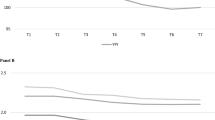Abstract
Despite increasing interest in understanding psychopathic traits in youth, the role of early environmental factors in the development of psychopathic traits is not well understood. No prior studies have directly examined the relationship between early life events and psychopathic traits. We examined links between life events in the first 4 years of life and indices of the core affective and interpersonal components of psychopathy. Additionally, we examined relationships between early life events, psychopathic traits, and attachment to parents among 206 adjudicated adolescents. Results indicated that the total number of early life events was positively correlated with indices of the affective component of psychopathy. Moreover, psychopathic traits moderated the relationship between the number of early life events and later reports of attachment to parents. Findings suggest that early environmental factors could have important implications for the development of psychopathic traits and may impact attachment to parents for youth with psychopathic traits.


Similar content being viewed by others
Explore related subjects
Discover the latest articles and news from researchers in related subjects, suggested using machine learning.Notes
The only difference in the pattern of results for transformed and untransformed variables was that the Affective facet X Life events interaction predicting attachment scores based on untransformed life events scores was marginally significant (p = .05) yet the interaction based on transformed life events scores only approached significance (p = .09).
References
Hare RD (2003) The Hare psychopathy checklist–revised, 2nd edn. Multi-Health Systems, North Tonawanda
Edens JF, Guy LS, Fernandez K (2003) Psychopathic traits predict attitudes toward a juvenile capital murderer. Behav Sci Law 21:807–828
Murrie DC, Boccaccini MT, McCoy W, Cornell DC (2007) Diagnostic labeling in juvenile court: how do descriptions of psychopathy and conduct disorder influence judges? J Clin Child Adoles Psychol 36:228–241
Frick P (2009) Extending the construct of psychopathy to youth: implications for understanding, diagnosing, and treating antisocial children and adolescents. Can J Psychiatry 54:803–812
Kosson DS, Cyterski TD, Steuerwald BL, Neumann CS, Walker-Matthews S (2002) The reliability and validity of the Psychopathy Checklist Youth Version (PCL: YV) in nonincarcerated adolescent males. Psychol Assess 14:97–109
Edens JF, Campbell JS, Weir JM (2007) Youth psychopathy and criminal recidivism: a meta-analysis of the psychopathy checklist measures. Law Hum Behav 31:53–75
Gretton H, McBride M, Lewis K, O’Shaughnessy R, Hare RD (1994) Predicting patterns of criminal activity in adolescent sexual psychopaths. Can Psychol 35:50–58
Forth AE, Kosson DS, Hare RD (2003) Hare Psychopathy Checklist: Youth Version (PCL: YV). Multi-Health Systems, North Tonawanda
McCord W, Mccord J (1964) The psychopath: an essay on the criminal mind. D. Van Nostrand, Oxford
Maher BA (1966) Principles of psychopathology: an experimental approach. McGraw-Hill, Oxford
Bacon MK, Child IL, Barry HA (1963) Crosscultural study of correlates of crime. J Abnorm Soc Psychol 66:291–300
McCord J (1979) Some child-rearing antecedents of criminal behavior in adult men. J Pers Soc Psychol 37:1477–1486
Blonigen DM, Carlson SR, Krueger RF, Patrick CJ (2003) A twin study of self-reported psychopathic personality traits. Person Individ Differ 35:179–197
Viding E, Frick PJ, Plomin R (2007) Aetiology of the relationship between callous-unemotional traits and conduct problems in 7-year-old twins. Br J Psychiatry 190:33–38
Brook M, Panizzon MS, Kosson DS, Sullivan EA, Lyons MJ, Franz CE, Eisen SA, Kremen WS (2010) Psychopathic personality traits in middle-aged male twins: a behavior genetic investigation. J Pers Disord 24:473–486
Livesley WJ (2008) Research trends and directions in the study of personality disorder. Psychiatr Clin North Am 31:545–559
Moffitt TE (2005) The new look of behavioral genetics in developmental psychopathology: gene-environment interplay in antisocial behaviors. Psychol Bull 131:533–554
Viding E, McCrory EJ (2012) Genetic and neurocognitive contributions to the development of psychopathy. Dev Psychopathol 24:969–983
Vitacco, Neumann, Ramos, Roberts (2003) Ineffective parenting: a precursor to psychopathic traits and delinquency in Hispanic females. Ann N Y Acad Sci 1008:300–303
Kimonis ER, Frick PJ, Munoz LC, Aucoin KJ (2008) Callous-unemotional traits and the emotional processing of distress cues in detained boys: testing the moderating role of aggression, exposure to community violence, and histories of abuse. Dev Psychopathol 20:569–589
Schraft C, Kosson D, McBride C (2013) Exposure to violence within home and community environments and psychopathic tendencies in detained adolescents. Criminal Justice and Behavior 40:1027–1043
Krischer M, Sevecke K (2008) Early traumatization and psychopathy in female and male juvenile offenders. Int J Law Psychiatry 31:253–262
Marshall L, Cooke D (1999) The childhood experiences of psychopaths: a retrospective study of familial and societal factors. J Pers Disord 13:211–225
Barker ED, Oliver BR, Viding E, Salekin RT, Maughan B (2011) The impact of prenatal maternal risk, fearless temperament and early parenting on adolescent callous-unemotional traits: a 14-year longitudinal investigation. J Child Psychol Psychiatry 52(8):878–888
Childs AW, Fite PJ, Moore TM, Lochman JE, Pardini DA (2014) Bidirectional associations between parenting behavior and child callous-unemotional traits: does parental depression moderate this link? J Abnorm Child Psychol 42(7):1141–1151
Fontaine NM, McCrory EJ, Boivin M, Moffitt TE, Viding E (2011) Predictors and outcomes of joint trajectories of callous–unemotional traits and conduct problems in childhood. J Abnorm Psychol 120(3):730
Adams D, Overholser J, Spirito A (1994) Stressful life events associated with adolescent suicide attempts. Can J Psychiatry 93:43–48
Brown G, Harris (1989) Life events and measurement. Life events and illness. Guilford Press, London
Hammen C (2005) Stress and depression. Annu Rev Clin Psychol 1:293–319
Deutsch L, Erickson M (1989) Early life events as discriminators of socialized and undersocialized delinquents. J Abnorm Child Psychol 17:541–551
Riser R, Brieman C, Kosson D (2011) The relationship of father involvement and family structure in psychopathic offenders. Poster session presented at the meeting of Society for Scientific Study of Psychopathy, Montreal
Bowlby J (1969/1982) Attachment and loss, vol. 1: attachment. Basic Books, New York
Greenberg M, Speltz M, DeKlyen M (1993) The role of attachment in the early development of disruptive behavior problems. Dev Psychopathol 3:413–430
Lyons-Ruth K (1996) Attachment relationships among children with aggressive behavior problems: the role of disorganized early attachment patterns. J Consult Clin Psychol 64:64–73
Green J, Goldwyn R (2002) Annotation: attachment disorganization and psychopathology: new findings in attachment research and their potential implications for developmental psychopathology in childhood. J Child Psychol Psychiatry 43:835–846
Lyons-Ruth K, Alpern L, Repacholi B (1993) Disorganized infant attachment classification and maternal psychosocial problems as predictors of hostile-aggressive behavior in the preschool classroom. Child Dev 64:572–585
Cleckley H (1976) The mask of sanity. C. V. Mosby, St Louis (Original work published 1941)
Flight J, Forth AE (2007) Instrumentally violent youth: the roles of empathy, attachment and psychopathy. Crim Just Behav 34:739–751
Andershed H, Hodgins S, Tengström A (2007) Convergent validity of the Youth Psychopathic Traits Inventory (YPI): association with the Psychopathy Checklist: Youth Version (PCL: YV). Assessment 14:144–154
Cauffman E, Kimonis ER, Dmitrieva J, Monahan KC (2009) A multi-method assessment of juvenile psychopathy: comparing the predictive utility of the PCL: YV, YPI, and NEO PRI. Psychol Assess 21:528–542
Das J, de Ruiter C, Doreleijers T, Hillege S (2009) Reliability and construct validity of the Dutch Psychopathy Checklist: Youth Version: findings from a sample of male adolescents in a juvenile justice treatment institution. Assessment 16:88–102
Blair RJR (1995) A cognitive developmental approach to morality: investigating the psychopath. Cognition 57:1–29
Blair RJR, Mitchell DGV, Leonard A, Budhani S, Peschardt KS, Newman C (2004) Passive avoidance learning in individuals with psychopathy: modulation by reward but not by punishment. Person Individ Differ 37:1179–1192
Marsh AA, Finger EC, Mitchell DG, Reid ME, Sims C, Kosson DS, Towbin KE, Leibenluft E, Pine DS, Blair RJR (2008) Reduced amygdala response to fearful expressions in adolescents with callous-unemotional traits and disruptive behavior disorders. Am J Psychiatry 165:712–720
Marsh AA, Finger EC, Fowler KA, Jurkowitz IT, Schechter JC, Yu HH, Pine DS, Blair RJR (2011) Reduced amygdala-orbitofrontal connectivity during moral judgments in youths with disruptive behavior disorders and psychopathic traits. Psychiatr Res Neuroimaging 194:279–286
Horesha N, Nachshonic T, Wolmera L, Torena P (2009) A comparison of life events in suicidal and nonsuicidal adolescents and young adults with major depression and borderline personality disorder. Compr Psychiatry 50:496–502
Bodell L, Smith A, Holm-Denoma J, Gordon KC, Joiner T (2011) The impact of perceived social support and negative life events on bulimic symptoms. Eat Behav 12:44–48
Coddington DR (1972) The significance of life events as etiologic factors in the diseases of children: I. A survey of professional workers. J Psychosom Res 16:7–18
Holmes T, Rahe R (1967) The social readjustment rating scale. J Psychosom Res 11:213–221
Armsden GC, Greenberg MT (1987) The inventory of parent and peer attachment: individual differences and their relationships to psychological well-being in adolescence. J Youth Adolesc 16:427–454
Wampler RS, Downs AB (2010) Parent and peer attachment in minority males at high risk for delinquency. Clin Soc Work J 38:107–119
Harpur TJ, Hare RD, Hakstian AR (1989) Two-factor conceptualization of psychopathy: construct validity and assessment implications. Psychol Assess 1:6–17
Hare R, McPherson L, Forth A (1988) Male psychopaths and their criminal careers. J Consult Clin Psychol 56:710–714
Benning S, Patrick C, Hicks B, Blonigen D, Krueger R (2003) Factor structure of the psychopathic personality inventory: validity and implications for clinical assessment. Psychol Assess 15:340–350
Poythress N, Skeem J, Lilienfeld S (2006) Associations among early abuse, dissociation, and psychopathy among offenders. J Abnorm Psychol 115:288–297
Hicks B, Carlson M, Blonigen D, Patrick C, Iacono W, McGue M (2012) Psychopathic personality traits and environmental contexts: differential correlates, gender differences, and genetic mediation. Person Disord Theory Res Treatment 3:209–227
Viding E, Blair RJR, Moffitt TE, Plomin R (2005) Evidence for substantial genetic risk for psychopathy in 7-year-olds. J Child Psychol Psychiatry 46:592–597
Burke JD, Loeber R, Lahey BB (2007) Adolescent conduct disorder and interpersonal callousness as predictors of psychopathy in young adults. J Clin Child Adoles Psychol 36:334–346
Murrie D, Cornell D (2002) Psychopathy screening of incarcerated juveniles: a comparison of measures. Psychol Assess 14:390–396
Acknowledgments
We wish to thank Susan G. Korpai, Rosemarie Gray, Louise Loud, Leonard Young, Michael Fletcher, Robert Cesar, the correctional officers, the adolescents at the Depke Juvenile Justice Complex in Illinois, J. Manley Dodson, and the court counselors of the Juvenile Services Division of Guilford County for their consistent support and cooperation of the research reported here. We also thank the staff of the Greensboro Detention Center and the staff of the Guilford Technical Community College at the Greensboro and High Point campuses for allowing us to interview adolescents and their families there. We thank Melanie Chinchilla, Josh Greco, Hillary Gorin, Sarah Hampton, Kristin Ridder, Cody Schraft, Rachel Tercek, Sarah VanMoffaert, and Lindsay Allen Whitman, for assessing participants in Illinois and Susan Baird, Deborah Carraway, Susan Dedmon, Jennifer Kelly, Leslie Loudermilk, Christine McBrien, and Julie Smith for assessing participants in North Carolina.
Author information
Authors and Affiliations
Corresponding author
Rights and permissions
About this article
Cite this article
Christian, E.J., Meltzer, C.L., Thede, L.L. et al. The Relationship Between Early Life Events, Parental Attachment, and Psychopathic Tendencies in Adolescent Detainees. Child Psychiatry Hum Dev 48, 260–269 (2017). https://doi.org/10.1007/s10578-016-0638-3
Published:
Issue Date:
DOI: https://doi.org/10.1007/s10578-016-0638-3




